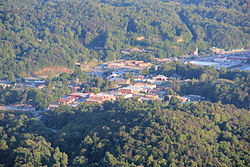Clayton, Georgia
| Clayton, Georgia | |
|---|---|
| City | |

View of Clayton from Black Rock Mountain State Park
|
|
 Location in Rabun County and the state of Georgia |
|
| Coordinates: 34°52′40″N 83°24′6″W / 34.87778°N 83.40167°WCoordinates: 34°52′40″N 83°24′6″W / 34.87778°N 83.40167°W | |
| Country | United States |
| State | Georgia |
| County | Rabun |
| Area | |
| • Total | 3.1 sq mi (8 km2) |
| • Land | 3.1 sq mi (8 km2) |
| • Water | 0 sq mi (0 km2) |
| Elevation | 1,929 ft (588 m) |
| Population (2011) | |
| • Total | 2,042 |
| • Density | 651.3/sq mi (252.4/km2) |
| Time zone | Eastern (EST) (UTC-5) |
| • Summer (DST) | EDT (UTC-4) |
| ZIP code | 30525 |
| Area code(s) | 706 |
| FIPS code | 13-16656 |
| GNIS feature ID | 0355183 |
Clayton is a city in Rabun County, Georgia, United States. The population was 2,019 at the 2000 census. The city is the county seat of Rabun County and is located in the Blue Ridge Mountains.
The area that would eventually become Clayton was called the Dividings because it sat at the intersection of three important Cherokee people trails. Explorer and naturalist William Bartram came through the Dividings in May 1775 while exploring what would later be organized as Rabun County. Much later, after Clayton had grown to include the Dividings, two of the old Cherokee trails were improved as the main roads for Clayton and the county: U.S. 23/441 and U.S. 76.
Claytonsville was founded by European-American settlers in 1821 as the seat of Rabun County. In 1823, the town was incorporated and renamed Clayton. It was named after a prominent jurist and congressman, Judge Augustin S. Clayton, who served in both the Georgia House of Representatives and Georgia Senate before being elected as a US Representative from Georgia, serving two terms from 1831–1835.
In 1824, 67 acres (270,000 m2) were purchased from Solomon Beck for $150, and city representatives laid out a site for a courthouse and the surrounding streets.
In 1904, the Tallulah Falls Railway was completed to Clayton from Cornelia, Georgia; it was extended to Franklin, North Carolina by 1907. Clayton has had public water and sanitary sewer service since the 1920s. Initially, the water supply was two springs on nearby Buzzard Roost Mountain, but today Clayton uses Lake Rabun as its water supply.
...
Wikipedia
